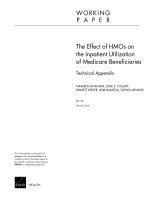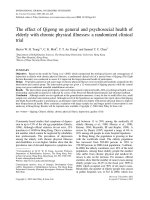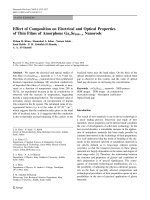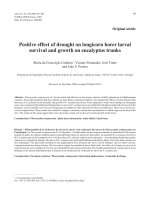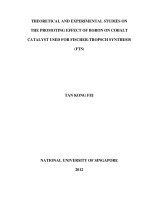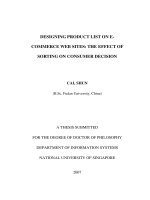Effect of physical properties of cotton on enzyme concentration
Bạn đang xem bản rút gọn của tài liệu. Xem và tải ngay bản đầy đủ của tài liệu tại đây (675.84 KB, 36 trang )
INFLUENCE OF ENZYMES
ON TEXTILE WET
PROCESSING
Aravin Prince Periyasamy
1
ENZYMES
Enzymes - Greek word “Enzymos”
Meaning - in the cell / from the
cell’.
Enzymes – Proteins composed of amino acids,
produced by all living organisms
Responsible for number of reactions & biological
activities.
Enzymes - Work efficiently and rapidly &
biodegradable.
Enzymes types - Malt, Bacterial, Pancreatic
etc,
Major functions - Hydrolysis, Oxidation,
Reduction Coagulation & Decomposition.
2
HYDROLASES ENZYME
Hydrolases - Mostly used enzyme in
textiles.
These enzymes are mostly preferred due to
following reasons
1) Accelerate the rate of the reaction
2) Specific in action
3) Low temperature operation
4) Safe and easy to control.
5) Replace harsh chemicals
6) No pollution
7) Biologically degradable
3
CHARACTERISTICS OF ENZYMES
Used during the process & can be
recovered at the end
Requires low activation energy - reaction
conditions are close to the ambient.
Sharp control over process conditions - very
sensitive to pH & temp variations.
Eco-friendly & accomplish their work quickly
and efficiently without leaving any pollutants
behind.
4
ENZYMATIC MECHANISM
First suggested by Emil Fischer in 1890s.
Enzymes - particular shape - substrate fit
exactly like “Lock and Key” model.
The active centers in the enzymes (Fissures,
Holes, Pockets, Cavities or Hollows) form
complex with the substrate.
The bio-reaction in this complex & its
destruction - release of original enzyme and
the product.
5
Enzymatic mechanism
6
MATERIAL SPECIFICATIONS
2 types of fabrics
Plain cotton woven fabric - desizing, Scouring,
Bio-polishing
3/1 twill weave Denim fabric - Denim washing
Plain cotton woven
fabric
Weave : Plain Woven
Fabric
EPI : 80
PPI : 60
GSM : 130
Warp Count : 60s Ne
Weft Count : 60s Ne
Denim fabric
Weave : 3/1 Twill
Woven Fabric
EPI : 26
PPI : 20
GSM : 180
Warp Count : 18sNe
Weft Count : 26s Ne
ENZYMATIC DESIZING
Most effective & widely used method for the
removal of Starch.
Use Starch liquefying enzymes in required
quantity under controlled condition of pH and
temperature.
Amylase enzyme from Malt extract were first
used to degrade starch-based sizes for cheap
and effective desizing.
Two categories of amylase
α-amylase
β-amylase
8
ENZYMATIC DESIZING (Contd…)
α-amylase attacks the starch randomly &
form Dextrins. Very rapid in action & produce
simple water soluble sugars.
The β-amylase converts starch into maltose
& it is slower in the rate of action.
The rate of desizing depends on the ratio of
these two amylases.
Higher α-amylase content - faster reaction
& vice versa.
9
MECHANISM OF DESIZING BY α- AMYLASE
ENZYME
PROCESS SEQUENCES
Recipe
α Amylase enzyme – 3%, 6% & 9% o.w.f
wetting agent – 0.5% o.w.f
pH – 8-10
M:L- 1:40
Temp - 55°c
Time – 1 hr
Sequence
Treat the fabric with the given recipe
Raise the temp of the bath to 55°c for 1 hr
Taken out the material and rinse with hot & cold water
Squeeze
Dry
11
Enzymatic desizing
EFFECT OF AMYLASE ON DESIZING
EFFICIENCY
Enzyme used:
Amylase Enzyme
S.
no
Enzyme Conc.
& Parameters
Untre
ated
3% 6% 9% Acid
Desizi
ng
1 Desizing
efficiency (%)
0 90 94 98 85
2 Strength Loss
(Kg)
48 47.3 46.5 46 44
EFFECT OF AMYLASE ON
DESIZING EFFICIENCY
0
20
40
60
80
100
120
Desizing Efficiency Strength Losss
Untreated
3%
6%
9%
Acid Desizing
BIO-SCOURING
Alkaline scouring – require harsh
chemicals, high temp & high effluent load
Bio-scouring - effective alternative to
chemical scouring.
Cottonase T & Pectinease enzyme is
widely used
Versatile, economically viable & eco-
friendly
14
PROCESS SEQUENCES
Recipe:
Sequence
Treat the fabric with the given recipe
Raise the temp of the bath to 55°c for 1 hr
Taken out the material and rinse with hot & cold water
Squeeze
dry
15
Enzyme used
Conc % (owf) pH Temp (°c)
Pectinease 1.5, 3 & 4.5% 6.0 60
Cottanase T 1.5, 3 & 4.5% 6.5 65
BIO SCOURING
EFFECT OF PECTINASE ON SCOURING
EFFICIENCY
Sl.
No
Desizing
conc (%)
3 6 9
1
Pectinase
Conc (%)
1.5 3 4.5 1.5 3.0 4.5 1.5 3.0 4.5
2
Absorbency
(Sec)
3.3 3 2.9 2.8 2.6 2.5 2 1.8 1.6
EFFECT OF PECTINASE ON SCOURING
EFFICIENCY
0
0.5
1
1.5
2
2.5
3
3.5
1.5 3 4.5
Pectinase Conc.(%)
Absorbency (Sec)
Amylase 3 % Amylase 6 % Amylase 9 %
BIO SCOURING
EFFECT OF COTTANASE T ON SCOURING
EFFICIENCY
Sl.
No
Desizing
conc (%)
3 6 9
1
Cottonase
Conc (%)
1.5 3 4.5 1.5 3.0 4.5 1.5 3.0 4.5
2
Absorbency
(Sec)
4.4 4.2 4.1 3.7 3.5 3.5 3.0 2.7 2.6
EFFECT OF COTTANASE T ON SCOURING
EFFICIENCY
0
0.5
1
1.5
2
2.5
3
3.5
4
4.5
5
1.5 3 4.5
Cottanase T 20 Conc.(%)
Absorbency (Sec)
Amylase 3 % Amylase 6 % Amylase 9 %
ADVANTAGES OF BIO-SCOURING
Milder conditions of processing and
excellent absorbency in goods.
No Oxy-cellulose formation and less
strength loss
Uniform removal of waxes.
Highly suitable for scouring of blends.
Low TDS in discharge.
Compared to conventional fabric is softer
20
APPLICATION OF ENZYME ON
FINISHING
Finishing - value addition process - hides
fabric defects & improves aesthetic value.
Enzymes application area in finishing process
Bio-washing
Bio-polishing
The fashionable stone wash look of denim
garment and other processes – applications of
cellulose finishing.
21
DENIM WASHING
Denim fabric - woven fabric of 3/1 twill
weave coarse counts of yarn
Warp - Indigo dyed yarn
Weft- Grey yarn.
Conventional method - faded effect
achieved by acid / stone wash.
Stone wash – garment/fabric rubbed
against pumice stones
Disadv: loss of strength & thickness of the
fabric.
MECHANISM OF DENIM WASHING
23
PROCESS SEQUENCES
Recipe:
Sequence
Load the fabric in drum dyeing machine
Add the water & wetting agent
Raise the temperature 60 0 C
Run the fabric for 20 min
Drain
Add the water and Laccase enzyme
Run the fabric for 60 min
Drain
Cold wash
Dry
24
Enzyme used Conc % (owf) pH Temp (°c)
Laccase 1, 1.5 & 2% 6.0 40
DENIM WASHING (Contd…)
Enzyme used - Cellulase enzymes
Advantages
Completely eliminate stone as the abrasive
agent in denim wash
Prevent damage to washing machines &
garments
Eliminates disposal of the used stones
Improves the quality of the waste water
No environmental pollution
Reduces processing time
Saves chemical & energy costs
